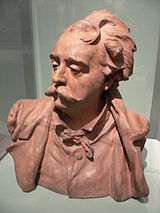- Modelling clay
-
 A bust of the sculptor Albert-Ernest Carrier-Belleuse, by Auguste Rodin (1882). Terracotta, originally modelled in clay.
A bust of the sculptor Albert-Ernest Carrier-Belleuse, by Auguste Rodin (1882). Terracotta, originally modelled in clay.
Modelling clay is a group of malleable substances used in building and sculpting. The material compositions and production processes vary considerably. [1]
Contents
Ceramic clay
Ceramic clays are water-based substances made from clay minerals mixed with other raw materials. They are baked at high temperatures, in a process known as firing to create ceramics, such as terra cotta, earthenware, stoneware, and porcelain.
Oil-based clay
Oil-based clays are made from various combinations of oils, waxes, and clay minerals. Because the oils do not evaporate as does water, oil-based clays remain malleable even when left for long periods in dry environments. Articles made from oil-based clays are not fired, and therefore are not ceramics. Because the viscosity of oils are inversely related to temperature, the malleability can be influenced by heating or cooling the clay. Oil-based clay is not soluble in water. It can be re-used and so is a popular material for animation artists who need to rework their models. It is available in a multitude of colours and is non-toxic.
Oil-based clays are referred to by a number of genericized trademarks. Plastilin, was patented in Germany by Franz Kolb in 1880. Plasteline was developed by Claude Chavant in 1892, and trademarked in 1927.[2]. Plasticine was invented in 1897 by William Harbutt of Bathampton, England. Plastilina is trademarked as Roma Plastilina by Sculpture House, Inc. According to their website, their formula is 100 years old[3].
Being readily worked in fine detail, Oil-based clays are also suitable for the creation of detailed sculptures from which a mold can be made. Castings and reproductions in a much more durable material can then be produced.
Polymer clay
Main article: Polymer clayPolymer clay is a material that will thermoset, that is, harden permanently when baked at a low temperature. Despite being called "clay", it generally contains no clay minerals. Polymer clay hardens by curing at temperatures created in a typical home oven generally at 129 to 135 °C (265 to 275 °F) for 15 minutes per 6 mm (1/4") of thickness and does not significantly shrink or change texture during the process.
Polymer clay is sold in craft, hobby and art stores, and is used by artists, hobbyists and children. Polymer clay is also popular in animation since it allows static forms to be firm and not be deformed by things like fingerprints and toolmarks while modifying the scene. Leading brands of polymer clay include Fimo, Kato Polyclay, Sculpey & Madello.
Paper clay
Main article: Paper clayPaper clays are cellulose based substances which air dry firm. The finished sculpture is extremely lightweight. There are two major groups of paper clay/paperclay users: those using paperclay as an unfired body and those using paperclay in the ceramic studio to make sculptural and functional studio pottery. Commercial air drying clay does not shrink noticeably when drying. This type of clay cracks more easily.
See also
- Papier-mâché (paper-maché), construction material made of paper and a wet paste.
- Salt dough, used for modelling, such as Play-Doh and Kanten Clay Studio.
- Clay (industrial plasticine)
References
- ^ Putman, Brenda, ‘’The Sculptor’s Way: A Guide to Modelling and Sculpture’’, Farrar & Rinehart, Inc, New York, 1939 p.8
- ^ http://www.sculpturetools.com/chavant/cart/plasteline.html
- ^ http://www.sculpturehouse.com/about_us.aspx
Categories:- Craft materials
- Sculpture materials
Wikimedia Foundation. 2010.



